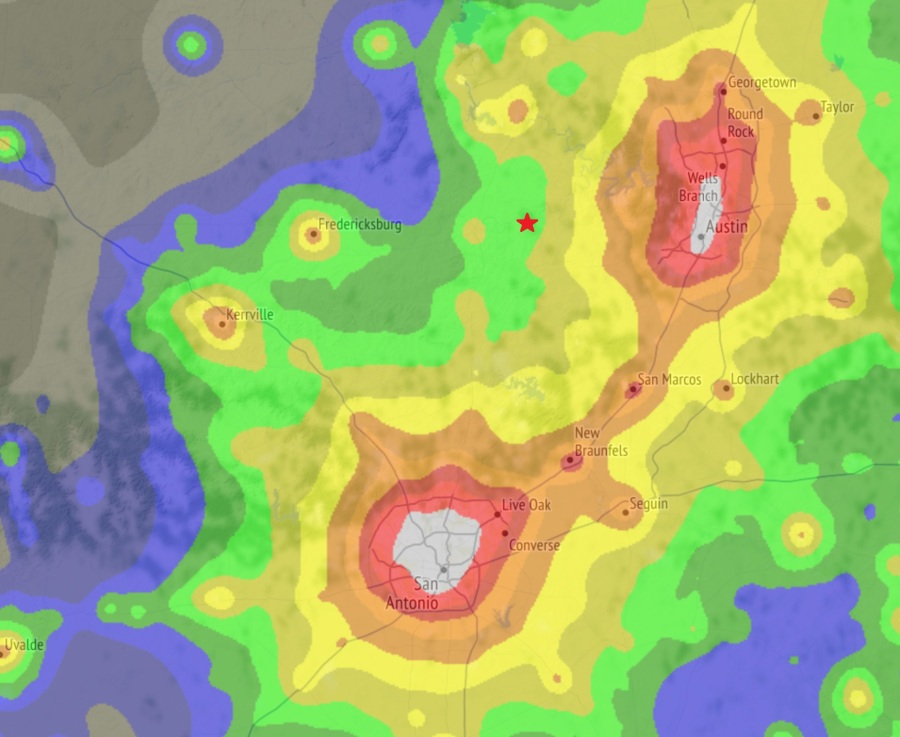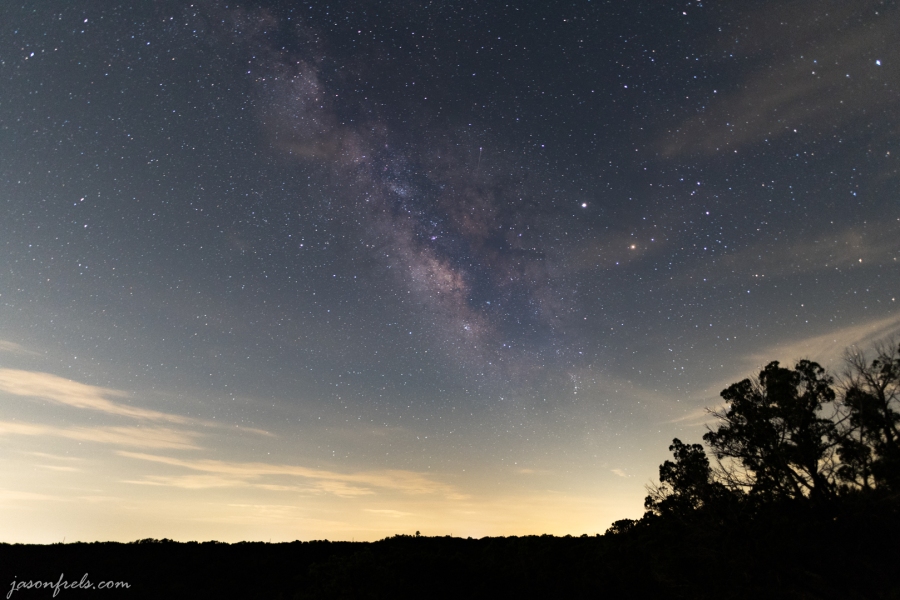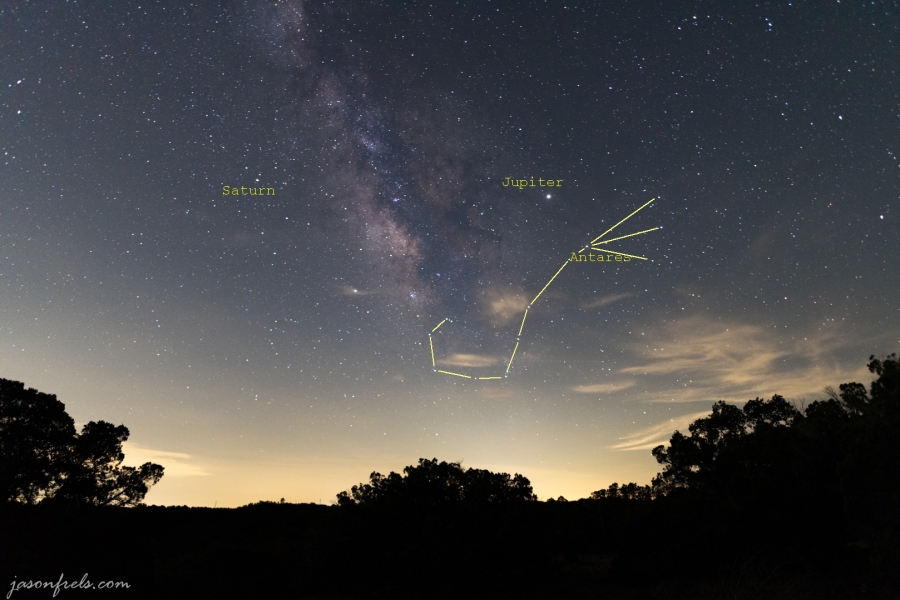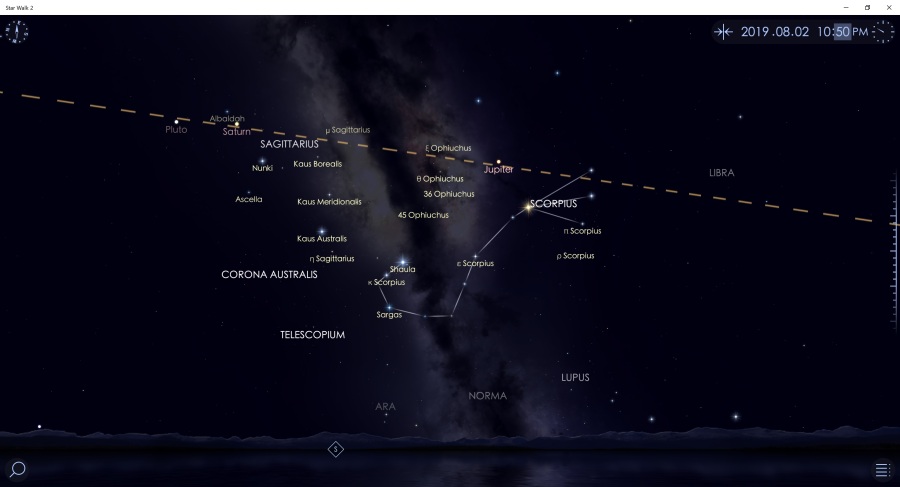I have been wanting to get out and take some night sky photos of the Milky Way this summer, but the weather and my personal schedule have not cooperated with me. So I watched the weather all week and made a plan for Friday night at Pedernales Falls State Park west of Austin.
Pedernales Falls State Park is close enough to Austin that I could drive out there after work and have a little time to scout around before the sun set at about 8:30. I reserved a primitive campsite so that I could be in the park late into the night with a parking permit on my vehicle. I parked, grabbed my camera gear, and hiked up the wolf mountain trail to hopefully find a nice overlook to the south for some Milky Way photos.
I did come across a scene on the trail, with the setting sun shining through some trees and illuminating the grass along the trail in front of me. I thought that the trail leading toward the setting sun with the grass in the foreground lit by golden light would make a nice photo.

I did put the camera in bracketing mode and clicked off five quick pictures to merge so I could avoid over-exposing the sky and still get the foreground.
I found a place to hang out for some sunset photos, but the sunset was unremarkable. This was good news though, as a nice sunset means high clouds and I didn’t want any clouds blocking the stars. Along the way I found a place that I wanted to set up for the night and I returned to this location to wait out the twilight.
Pedernales Falls State Park is not in one of the darkest areas of the state, but as I said it is close enough to Austin for an after work drive. The below image is a screen capture from darksitefinder.com. I placed a red star over the park to show its relation to the large cities of Austin and San Antonio. The park is not in the worst parts of the light pollution from the large cities, but it is going to get some light pollution on the horizon. Getting to the darker areas in west Texas requires driving several hours. It took me two hours in afternoon traffic just to get to Pedernales Falls State Park (there are no direct roads).

I decided to pack a folding chair along with me so that I’d have a comfortable place to sit and wait out the twilight. This was definitely worth the added weight to my pack. I also brought my Kindle and read a little. After sun down, it wasn’t cool but I did get a light breeze. It was very quiet out there aside from the occasional jet passing over and some coyotes in the distance waking up for the night. I saw Jupiter appear in the sky and watched as the stars slowly became visible. I also saw the occasional meteor and several satellites moving across the sky. Twilight ended at about 10:00 PM and I began taking photos.
For this outing I brought my camera (Nikon D750), a Nikkor 20mm f/1.8 lens, a tripod, and a spare battery. For camera settings, I started with f/1.8, 15s shutter time, and ISO1600, with long exposure noise reduction enabled. I experimented with different white balance settings, but in the end I just left it on auto. The orange light pollution was going to make a mess of any white balance and I figured that I’d be dealing with it in post anyway.
I was able to manually set focus in live view by zooming in on Jupiter (the brightest object in the sky) and adjusting the focus until the planet was a tiny point of light. I used a wireless remote shutter with a 2 second delay to minimize any camera shake that would blur the stars.

The sky was unfortunately kind of hazy even though there weren’t a lot of clouds. The haze obscured the stars and picked up the light pollution. I watched during the week as the forecast went from clear to partly cloudy, but I had hopes for some nice pictures. As you can see in the image above there were some clouds on the horizon picking up the light pollution. I could actually see the Milky Way with my own eyes; I certainly can’t see it in the city.
One thing that I wanted to work on was getting some sort of foreground in the shot. I experimented with an old tree stump that I thought might look good. I set up low behind the stump, trying to keep the trees out of the background, and kept focus on the stars.

To light the stump, I used my head lamp with my hand held over it. I moved my hand for just a second during the 20 second exposure to get a little light on the stump. This was probably too much light. Being this close to the stump with the focus set at infinity, the stump is a little blurry. If I was serious about this composition, I could have done some focus stacking and worked on the lighting, but I didn’t really think that the stump was working.
Another thing that you will notice in the above photos if you look closely, is the faint streak of satellites moving across the sky. This is most noticeable just after/before twilight while the satellites are still getting sunlight. This is only going to get more common in the future.
Another aspect of night sky photography that I am starting to enjoy is identifying stars and planets. I have an app called Star Walker on my computer that I use to identify major stars and constellations. Below is a screen capture of the simulated southern sky from Austin at the time I was shooting photos. You can see Jupiter, Saturn, and the constellation of Scorpius. The Sagittarius constellation is up there too, but it is much larger and difficult for me to make out.
Compare this to my photo below on which I have marked Jupiter, Saturn, and Scorpius:

Zooming in you can find lots of interesting things like the Ptolemy Star Cluster, the Laguna Nebula, and several other asterisms.
Overall I did 4 or 5 miles of hiking carrying my camera gear, which was nice because I need the exercise, but even late at night it is still quite warm out there (mid 80s F). It was a long walk back to the car in the middle of the night, but the trail is generally very wide and smooth and I had my headlamp to light the way.

There are darker areas of Texas that are better for night sky photography that I would like to get out to. For instance, Lost Maples State Natural Area where I went last July, you can really see the difference in light pollution looking at those pictures. I haven’t been able to find the time and clear weather to make this happen yet this year. I would really like to get out to Big Bend National Park for this Milky Way season, but haven’t been able to make it happen.
I hope you enjoyed my night sky photos. Thanks for reading and leave a comment below if you like.


What amazing photos! The night sky is very distinct in your pictures despite the light pollution. 😎👍
LikeLiked by 1 person
Thanks. I did spend quite a bit of time in LightRoom this morning editing photos trying to bring out the sky a bit. I also de-saturated the oranges and yellows to bring the light pollution down.
If I could just get everyone in the San Antonio metro area to shut off their lights for an hour or so.
LikeLiked by 1 person
I know, what are they thinking, using their electricity when your trying to get some awesome pictures? How inconsiderate!
LikeLiked by 1 person
Ha. The more ironic thing is that I am an electrical engineer so this is all partially my fault.
I also almost went into a semi-rant about the crazy path to nowhere that Apple maps took me on getting to the park. I hadn’t been to the park coming out of South Austin before and I used the map on my iPhone. I finally realized that the map was getting me lost when it told me to enter some rancher’s property and I pulled over and plotted my own course.
LikeLiked by 1 person
Oh I know what you mean, those maps are totally off. As far as your electrical background is concern, all I have to say is go pull the big plug! Lol
LikeLiked by 1 person
Fantastic shots! I have been wanting to try out astrophotography but I do not know much about it. Also, I was not sure where the best places in Texas were to take photos. Big Ben is too far from me but this park I have been to a couple of times and is doable in a day trip.
LikeLiked by 1 person
It is difficult if you live in the city like I do. In my opinion, Pedernales Falls is just on the edge of being a good place to shoot the night sky. There is quite a bit of light pollution there. It may be better to go a little farther west to Enchanted Rock State Natural Area.
I have had some good luck at Colorado Bend State Park. It is a bit of a drive out from Austin though.
The best place I have been is Lost Maples State Natural Area. But, it is quite a drive and I hiked in to a campground up on a ridge which was quite a work out.
You may like to check out darksitefinder.com and plan out where you can get too. I also use photopills to plan for milky way visibility.
Unfortunately Milky Way season is in the summer and most of the good places in Texas for a dark sky are out in the desert where it is hot. But, it is worth suffering some heat I suppose. I really want to get to Big Bend for the night sky. 8 hour drive for me.
Thanks for reading and commenting.
LikeLiked by 1 person
Wow, thank you for the information. I have been to Colorado bend a few times but not Lost Maples so I will have to look into that one, I don’t mind a hike! I have only researched what settings for my gear so the other information is most helpful. I had no idea there was a season for the Milky Way! I will also visit the website you have provided, you’ve been most helpful.
LikeLiked by 1 person
Big Bend*
LikeLike
Very nice, in my opinion. I couldn’t make out the satellite blurs, so I’ll just trust you that they’re there.
LikeLiked by 1 person
In the tree stump photo, if you look closely at the top middle, you can see a vertical streak. I am pretty sure that this is a satellite. The airplanes leave a spotted streak as they have blinking red and green lights.
I guess it could have been a meteor as it is Persieds season, but I would expect it to be brighter. I saw a lot of satellites moving across the sky last night, so I assume it was a satellite. As they build the internet satellite networks in low earth orbit in the coming years, it is going to get pretty bad for us night sky shooters. Thanks a lot, Elon.
LikeLiked by 1 person
Ah yes, I see the streak now. Of course that could be a space alien streaker.
LikeLiked by 1 person
Looking through some of my other photos, I caught quite a few meteors and satellites.
I would expect the satellites to have a streak length in relation to the exposure where as meteor would streak faster across the sky and leave a longer streak.
I am not sure how long a streak created by an alien would be. I don’t remember encountering any aliens last night, but they could have wiped my memory.
LikeLiked by 1 person
😀
LikeLiked by 1 person
Great pictures, I am so jealous. I have been Milky Way hunting all summer. Lost Maples, Pedernales and Caprock Canyon. I did see the Milky Way at Lost Maples but my timing and the weather hindered the other parks. Next year I will get some advice from you on times and places. Big Bend sounds awesome for a dark sky.
LikeLiked by 1 person
The weather has not cooperated with me the last few months. Every time there is a new moon and I have some time, it has been cloudy.
I had good luck at Lost Maples last year. It was fantastic out there. I have had good luck at Colorado Bend as well. I tried Caprock Canyons and got clouds.
You might find darksitefinder.com a useful website. There is a map on there of light pollution. That and just watch the moon setting times.
It is nice to tie hiking in with this for exercise as well.
Thanks.
LikeLiked by 1 person
I used darksitefinder and it worked great. The full moon threw me off at Pedernales.
LikeLike
Yeah, a full moon is way too bright.
Last night the sliver of moon went down during twilight.
I use PhotoPills to plan twilight and the direction and angle of the galactic core.
LikeLike
Is there much water in the river this time of year?
LikeLike
I didn’t go down to the river, but the creek beds that I went through were dry.
LikeLike
Very cool, and thanks for the tip about Star Walker – I’ve got to try it out!
I’ve been wanting to get out and shoot the Milky Way this season too, but living in Orange County and having a newborn just aren’t allowing me any opportunities for a quick trip.
LikeLiked by 1 person
Yeah, a newborn makes it hard to justify many things. They grow up quickly. They were taking a nap in my lap one day and going to high school the next it seemed.
I have to drive a long way from Austin to get dark skies. Pretty much out to the desert.
LikeLike